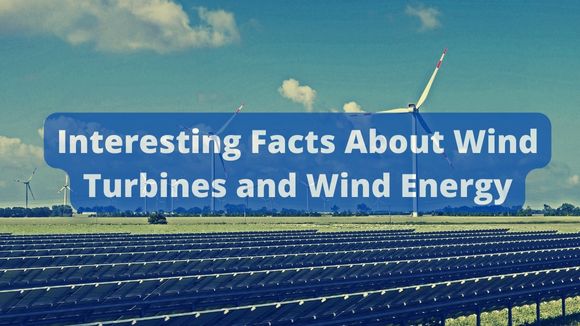Wind energy is a type of renewable energy that is derived from the wind. Wind turbines convert the kinetic energy in the wind into mechanical or electrical energy. Wind energy has been used for centuries to power boats and mills. Today, wind turbines are used to generate electricity in many parts of the world.
Wind energy is a clean and renewable source of energy. It does not produce carbon emissions, which means it does not contribute to climate change. Wind turbines also take up very little space, so they do not impact wildlife or habitats.
Wind turbines are becoming increasingly popular because they are a cost-effective way to generate electricity. They also help reduce our dependence on fossil fuels, which can lead to less air pollution.

Did you know that wind energy is a form of renewable energy that has been used for centuries to power boats and mills? Or that wind turbine becoming an increasingly popular way to generate electricity because they are cost-effective and help reduce our dependence on fossil fuels?
If you’re interested in learning more about the fascinating world of wind energy, keep reading. In this blog post, we will share some interesting facts about wind turbines and wind energy. So, whether you’re a lifelong environmentalist or just starting to learn about renewable resources, we hope you’ll find this information interesting!
Wind Turbines and Wind Energy Facts
Wind energy is one of the oldest forms of energy production. The first windmills were developed in 200 BC in Persia and China and were used for a variety of applications, including irrigation, power generation, and grain grinding. Wind energy continued to be used throughout the centuries, with windmills appearing in Europe in the Middle Ages and eventually making their way to the United States in the late 1800s.
To provide its own power, a building in China is built with embedded wind turbines incorporated into it. The idea is that the turbines will generate enough electricity to power the building, eliminating the need for traditional power sources.
In the 1940s, the first modern turbine was built in Vermont. The original design was based on the way water wheels had been used for centuries in power mills. However, the new turbines were much more efficient, and they quickly began to be used for a variety of purposes, including generating electricity.
Wind turbines can be dangerous to bats. When a bat flies near the blades of a turbine, the decrease in air pressure can cause its lungs to explode. This is known as “barotrauma.” While this may seem like a rare event, it’s actually quite common.
If you’ve ever seen a wind farm up close, you know that turbine towers are massive. They typically stand over 328 feet tall, which is taller than the Statue of Liberty. And each turbine blade is around 260 feet long. The latest blades can extend over 300 feet, making them some of the longest in the world.
When it comes to renewable energy sources, there are a lot of options to choose from. Solar, hydro, biomass… the list goes on. But of all the renewable energy sources out there, wind energy is the only one that doesn’t require water. That might not seem like a big deal, but when you consider that close to 70% of the world’s freshwater is used for thermoelectric power generation, it starts to seem like a pretty big deal.
Just a few decades ago, the wind turbine was a primitive machine that had only a handful of moving parts. Today’s wind turbines are vastly more complex, with as many as 8,000 different components. The blades alone are sophisticated structures that are designed to capture the maximum amount of wind energy. The machinery that makes up the rest of the turbine is just as critical, from the gearboxes that transfer energy to the generators that produce electricity. Even the tower that supports the turbine is an engineering marvel, designed to withstand the force of hurricane-strength winds.
According to the US Energy Department, if you’re interested in installing a wind turbine, you can use their wind resource map to see how much potential wind energy exists in your area. The map shows average wind speeds and the capacity for generating power. The department stresses that these are only averages, so your actual results may vary depending on the exact location of your turbine. They also note that while the map is a helpful tool, it’s not the only factor you should consider when deciding whether or not to install a turbine.
A single commercial turbine can generate enough electricity for 600 homes. That’s a lot of power! And it’s not just homes that can benefit from this technology. Businesses and factories can also use turbines to generate electricity. It’s amazing to think about how much power one turbine can generate.
To generate electricity, wind turbines need to be in an area with high wind speeds. That’s why turbines are getting taller – so they can reach the higher heights above ground level, where the winds are even stronger. With taller turbines, we can generate more electricity from the same amount of land.
The Bahrain World Trade Center is a groundbreaking building in more ways than one. Not only is it the tallest skyscraper in Bahrain, but it’s also the first skyscraper in the world to integrate wind turbines into its design. The turbines are located between the two towers of the construction and are capable of generating enough electricity to power the entire building.
More than 17.5 US homes may be powered with the same amount of wind energy that was generated in 2014, according to estimates. That’s all of Vermont, California, DC, Delaware, Rhode Island, North Dakota, South Dakota, and Alaska combined.
Who would have thought that one day we’d be harnessing energy from the sky? But that’s exactly what flying wind turbines are designed to do. These turbines are tethered to the ground and use the wind to generate power. The blades of the turbine are constantly in motion, which makes them much more efficient than traditional turbines. And because they’re airborne, they can take advantage of higher and more consistent winds.
If you think regular-sized wind turbines are huge, wait until you see the new Gargantuan Wind Turbine! This massive structure is so large that you could fit two professional baseball fields inside the area it sweeps.





